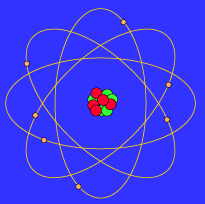Many oxidation-reduction reactions occur spontaneously, giving off energy. An example involves the spontaneous reaction that occurs when zinc metal is placed in a solution of copper ions as described by the net ionic equation shown below.
Cu+2 (aq) + Zn (s) -------> Cu(s) + Zn+2 (aq)
The zinc metal slowly "dissolves" as its oxidation produces zinc ions which enter into solution. At the same time, the copper ions gain electrons and are converted into copper atoms which coats the zinc metal or sediments to the bottom of the container. The energy produced in this reaction is quickly dissipated as heat, but it can be made to do useful work by a device called, an electrochemical cell. This is done in the following way.
An electrochemical cell is composed to two compartments or half-cells, each composed of an electrode dipped in a solution of electrolyte. These half-cells are designed to contain the oxidation half-reaction and reduction half-reaction separately as shown below.

The half-cell, called the anode, is the site at which the oxidation of zinc occurs as shown below.
Zn (s) ----------> Zn+2 (aq) + 2e-
During the oxidation of zinc, the zinc electrode will slowly dissolve to produce zinc ions (Zn+2), which enter into the solution containing Zn+2 (aq) and SO4-2 (aq) ions.
The half-cell, called the cathode, is the site at which reduction of copper occurs as shown below.
Cu+2 (aq) + 2e- -------> Cu (s)
When the reduction of copper ions (Cu+2) occurs, copper atoms accumulate on the surface of the solid copper electrode.
The reaction in each half-cell does not occur unless the two half cells are connected to each other.
Recall that in order for oxidation to occur, there must be a corresponding reduction reaction that is linked or "coupled" with it. Moreover, in an isolated oxidation or reduction half-cell, an imbalance of electrical charge would occur, the anode would become more positive as zinc cations are produced, and the cathode would become more negative as copper cations are removed from solution. This problem can be solved by using a "salt bridge" connecting the two cells as shown in the diagram below. A "salt bridge" is a porous barrier which prevents the spontaneous mixing of the aqueous solutions in each compartment, but allows the migration of ions in both directions to maintain electrical neutrality. As the oxidation-reduction reaction occurs, cations ( Zn+2) from the anode migrate via the salt bridge to the cathode, while the anion, (SO4)-2, migrates in the opposite direction to maintain electrical neutrality.
The two half-cells are also connected externally. In this arrangement, electrons provided by the oxidation reaction are forced to travel via an external circuit to the site of the reduction reaction. The fact that the reaction occurs spontaneously once these half cells are connected indicates that there is a difference in potential energy. This difference in potential energy is called an electomotive force (emf) and is measured in terms of volts. The zinc/copper cell has an emf of about 1.1 volts under standard conditions.

Any electrical device can be "spliced" into the external circuit to utilize this potential energy produced by the cell for useful work. Although the energy available from a single cell is relatively small, electrochemical cells can be linked in series to boost their energy output. A common and useful application of this characteristic is the "battery". An example is the lead-acid battery used in automobiles. In the lead-acid battery, each cell has a lead metal anode and lead (IV) oxide (lead dioxide) cathode both of which are immersed in a solution of sulfuric acid. This single electrochemical cell produces about 2 volts. Linking 6 of these cells in series produces the 12-volt battery found in most cars today. One disadvantage of these "wet cells" such as the lead-acid battery is that it is very heavy and bulky. However, like many other "wet cells", the oxidation-reduction reaction which occurs can be readily reversed via an external current such as that provided by an automobile's alternator. This prolongs the lifetime and usefulness of such devices as an energy source.



No comments:
Post a Comment